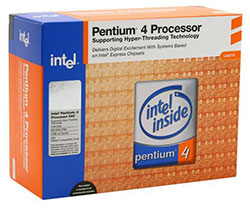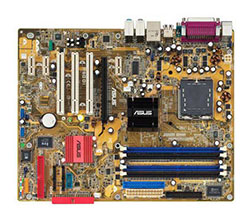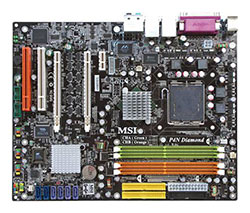Buyer's Guide: Mid-Range to High-End, May 2005
by Jarred Walton on May 23, 2005 5:30 PM EST- Posted in
- Guides
Intel Recommendations
Intel Processors
There are always people who continue to prefer Intel processors for whatever reason. We feel that AMD has the upper hand right now - both in price as well as performance - but there are merits to the Intel platform. We've said it many times before, but let us reiterate that anyone interested in serious 3D gaming should just forget the Intel chips for now. It's really that cut and dry, unfortunately. The dual core Pentium D 8xx parts should also show up at retail any time now, and since multitasking is probably the best argument for Intel enthusiasts, we would seriously recommend waiting for those chips. Those looking to purchase an Intel system now still need to make the decision between 5xx with higher clock speeds and 6xx with more features. (The 5xx chips with EM64T are not yet available either.) In the end, we still can't offer a "one size fits all" choice, so we're declaring it a draw between the two processor lines. You can get a similarly priced 5xx or 6xx chip for both price points, but we're going with 5xx for the Mid-Range and 6xx for the High-End.Intel Mid-Range Recommendation
Processor: Pentium 540J 3.2GHz 1MB (Retail) - Prescott core
Price: $213 Shipped
It's telling that the most reasonably priced CPU from Intel continues to be their 3.2 GHz part. Wasn't the 3.2C originally launched almost two years ago? Anyway, faster Pentium chips are available, but the price scales rapidly. You could even opt for the 3.0 GHz 530J and still get reasonable performance - particularly with overclocking. Although, make sure that you get an appropriate motherboard if you plan on overclocking with an Intel chipset! The 6xx series counterpart to the 540J is the 630, which comes clocked at 3.0 GHz, costs $15 more, and comes with 64-bit support and more cache. If you want to overclock, we'd suggest forgetting 64-bit support and sticking with the 5xx series - doubling the L2 cache does not help with overclocking, needless to say. Still, feel free to try your luck.
Intel High-End Recommendation
Processor: Pentium 650 3.4GHz 2MB (Retail) - Irwindale/Prescott 2M core
Price: $412 Shipped
With the High-End Intel setup, we feel that it only makes sense to grab a 64-bit capable processor. Not everyone is going to need the ability to run XP-64, but if you're going to spend over $400 on a CPU, we think that you're more likely to be part of the bleeding edge who likes to try all the latest and greatest hardware and software. If you disagree or still feel that clock speed is king, the Pentium 560J runs at 3.6 GHz and omits support for EM64T, all while costing $7 (wow!) less. (The 561 should arrive some time in the next couple of months if you're interested in 64-bit support without the 2MB cache.)
The difference between the Mid-Range and High-End Intel processors ends up being just 400 MHz - only 12% to 13% faster in terms of clock speed. Of course, you could also take the CPU recommendation up one more step to the 570J or 660, which would add another $200. (We don't think that it's worth it either.) It's interesting to note that we've had reasonable success running most recent Prescott "J" chips with a 14X multiplier and 1066FSB. All new Pentium 4 processors support EIST, which allows them to reduce the CPU speed and voltages and drop down to 2.8 GHz on an appropriate motherboard. Most enthusiast motherboards allow you to lock the multiplier at 14X and run with the faster bus speed. 3.73GHz ends up outperforming everything including the 570J (due to the increased bus speeds and memory bandwidth, although it's basically a tie) while costing hundreds of dollars less, but nothing is guaranteed with overclocking and some people prefer the guaranteed performance at stock speeds.
Intel Motherboards
The best motherboards for Intel processors pretty much always use Intel chipsets. That may change with the new NVIDIA nForce 4 SLI chipset, but motherboards using the NVIDIA chipset are difficult to find at retail. Furthermore, the new dual core Pentium D processors will require a new chipset to work. That means Intel's 945 and 955 chipsets or the aforementioned nForce 4 SLI for 775. We're still waiting for widespread retail availability (as well as a price drop), which should hopefully come during the next couple of weeks. Newegg and ZipZoomFly (and a few others) have the ASUS P5WD2 (955X) and the MSI P4N Diamond (nF4 SLI), but both cost nearly $250 right now and you still can't find dual core processors. All these factors combined make it difficult to recommend any current socket 775 motherboard, but it's not impossible. There are many good motherboards for both platforms, so just because we don't specifically mention a motherboard, it doesn't mean it's a poor choice. Rather than trying to list the pros and cons of dozens of motherboards, we would suggest that you visit our forums if you want further advice. (Or you can always try emailing us.)Intel Mid-Range Recommendation
Motherboard: ASUS P5GD1
Price: $110 Shipped
There are several things that we're looking for in a decent socket 775 motherboard for a Mid-Range PC. First, we want HD audio and GbE - preferably on the PCIe bus for GbE. We've talked about the difference in price between DDR and DDR2 in the past, but now prices have dropped to the point where that isn't as big of a concern; what's important now is that the board needs to have four memory slots of the same type, since you can't use DDR and DDR2 at the same time. We've never been fans of combo memory designs, as they usually involve a compromise, and that's the case here. Additional features are welcome, but not required, and in the end, we're back to the same ASUS motherboard from our last Mid-Range Guide, albeit with a reduced price. The P5GD1 meets all of the above, and adds in more PATA connectors, good overclocking support, ASUS' proven reliability, and it's still one of the cheaper 775 boards.
The usual suspects are all there with competing products, but they all cost more without offering a whole lot in the way of improved features. The EPoX EP-5EPA+ did well in our roundup, but it's still just a similar product to the ASUS at a higher price. The same goes for the Abit GD8, while the AG8 adds Firewire ports (the only real omission on the ASUS board). The only board that offers something really different from the ASUS is the MSI 915P Neo2 Platinum. It supports DDR2 memory and also has a Firewire connection. Why would you want DDR2 memory? We'll cover this more in the RAM section, but the short answer is that the price/performance for overclocking setups is pretty good.
Intel High-End Recommendation
Motherboard: MSI P4N Diamond
Price: $229 Shipped
Our High-End board is one of the most expensive motherboards that we've ever recommended, and we're giving this recommendation with quite a few caveats. First, we assume that dual core support will work properly (we haven't officially tested it). The bigger factor is that it's one of the few current Intel platform motherboards to support SLI, so if you want Intel and you want the most powerful gaming configuration possible, then you want an nForce 4 SLI board. If you can find a Pentium D to go with this board, our misgivings are not as severe, as certain multitasking tests show that Intel can still beat AMD in that area - particularly when you consider that Pentium D should be available before and cost significantly less than Athlon X2. Just remember that you're spending $70 extra on the motherboard, which certainly cuts into the cost benefits of the platform.
If you want SLI and you don't want to wait for Pentium D to show up at retail, then you're better off with the AMD platform. If you still insist on Intel, that's your right, but most people would say that you're being stubborn. Then again, the cost of a Pentium 4 540J (3.2 GHz) now and a Pentium D 830 (3.0 GHz) later would still be less than the current suggested cost of the cheapest Athlon 64 X2. (My, how the times have changed.) Coupled with the current release schedule - Pentium D should appear at retail several months before Athlon X2 - the High-End, early adopter who demands multitasking performance will probably want to give Intel options some thought. You could always look to SMP workstation setups as well, but then you lose SLI, and that's not something that we want to do for our High-End recommendation.
We should also mention the other SLI option for Intel, the ASUS P5ND2-SLI Deluxe. We've tested that board (along with the P5WD2) and it certainly offers a lot of features. The reason why we didn't recommend it over the MSI board is that it costs an extra $50. Perhaps the MSI board will support DDR2 RAM running at DDR2-1000 speeds and perhaps not. However, most of us don't feel that the additional percentage points gained in performance are worth the increased cost. For gamers, full SLI support is far more important than increased memory speed support.














60 Comments
View All Comments
Tujan - Tuesday, May 24, 2005 - link
Err a,thanks for reply..Calin.bummer when I do that.
Garyclaus16 - Tuesday, May 24, 2005 - link
All this article tells me is that my once 'bleeding edge' [939 Athlon64 3200+]system is now merely a mid range PC...save for my pqi turbo 2-2-2-5 :PStill...I am sad...I need to save up another 2k now for later this year. > :(
Tujan - Tuesday, May 24, 2005 - link
Thanks for reply Chris..Yeah Ive followed a few stories about the VIA Edens. Just hovering around 1 GHz. With single PCI slot.They too,have onboard graphics. Like pull that off , keep onboard sound maybe,...
Certainly limiting themselves with that kind of choice.Then Im not what that is suppose to reach. Two PCI-e slots at minimum for me.But this sends the engineers back to work.
Most vendors Iv seen include the graphics onto the mini-atx motherboards. MSI has an mini-atx w/o graphics ,..775.But isn't seen at vendors. Situation with the power,could make do with feature set of 915..945,955/Nvidias on mini-atx(s),.Since the lan is onboard.Might consider having maybe single Sata as well.
Not like being able to see clearly now...""I can see clearly now the rain is gone""..:)
Weird how we will see magic in closed black box embedded solution before we have that choice.
ProviaFan - Tuesday, May 24, 2005 - link
I agree with #34 for the most part, but anyone heavily into digital photography (whether with DSLR or scanned film) knows that it is very easy to exceed 1GB with Photoshop and a few images with some adjustment layers and layer masks (not to mention that my PC is general purpose and I usually have other stuff going in the background as well).stickx - Tuesday, May 24, 2005 - link
quoted from the guide: "long-time favorite, the OCZ Rev. 2 Platinum. While the price increase is quite drastic, it's worth mentioning that this same RAM cost as much as $275 just a few months back. It uses Samsung TCCD memory blanks"Unfortunately OCZ is no longer using TCCD memory in this product. This has been verified on several forums in xtremesystems.org and in dfi-street.com where people have removed the heat spreaders to find chips other that TCCD. I think you need to update your guide for this info.
OrSin - Tuesday, May 24, 2005 - link
Damn people get off thier backs. It a damn guide. Make all the choices you. They are giving thier recommondation, they are not give you ever fcking choice under the sun. No guide can have everyones choice.And ars, I don't know what planet your from but if you think epox is even near Asus or MSI in quality then then you full of it. If i saw any sit say Exop is better then ASUS, then I would stop reading them. Better then chaintech ost likely then not the top tier guys.
And for the record I play alot games and have noticed no improvement with 2GB of 1GB or memory.
Don know what you do thet 2GB is needed. Now I'm not saying you can;t find a way to use more then 1GB, but how many people actually do and on a regular bases.
Pythias - Tuesday, May 24, 2005 - link
When you guys refer to response time, is thet grey-to-grey, black-white-black, or total response time?MrOblivious - Tuesday, May 24, 2005 - link
Supposedly the issue with MSI NEO4 boards and 90nm chips has been fixed:http://forum.msi.com.tw/index.php?topic=80384.0
arswihart - Tuesday, May 24, 2005 - link
Kris - so you are now saying all mobo makers are essentially equal in terms of support, upgrades, MTBF (bad caps excuse is dead now since they all use good/great quality caps). So what's left to make me choose Asus/MSI? If you are saying reputation, I can just direct you to the forums, their boards are no better or worse than any of the competition. If you are recommending based on sales, thats just dumb.ceefka - Tuesday, May 24, 2005 - link
#1 I don't know how the onboard will handle sound in games, but I'd count on it to do that on the level it is built, i.e. no better than it will play a CD or DVD. It is however safe to say that onboard will definately not work for (semi)professional audio on a PC.I always thought that any realtime sound effects were handled by the CPU, unless you have a dedicated DSP-card or multiples thereof which gamers seldom do ;-)
Jarred: "anyone who doesn't intend to do any recording of audio" and what about those that do? I do read a lot about DAW's on the net, but have to get back to AT regularly to get a the details straight.
What do you make of this? http://www.rme-audio.com/english/techinfo/nforce4_...
With the Thonex audio stress test file (downloadable from http://www.adkproaudio.com/downloads.cfm), including memory-intensive data communication via samples/VSTis, and used with Cubase SX/Nuendo 2/3, soundcard latency has to be increased to approx. 2048 samples buffer latency setting with the NF4 to receive glitch-free audio recordings whereas with the NF3, and equivalent software/hardware/soundware equipment, the minimum latency can be significantly reduced (some 128-256 samples). Likewise, cpu load values are significantly higher with the NF4 than with the NF3 ditto - based on exactly the same audio stress test files and equivalent hardware peripherals.
The Thonex could be nice for your next high end guide when the dualcores are out.